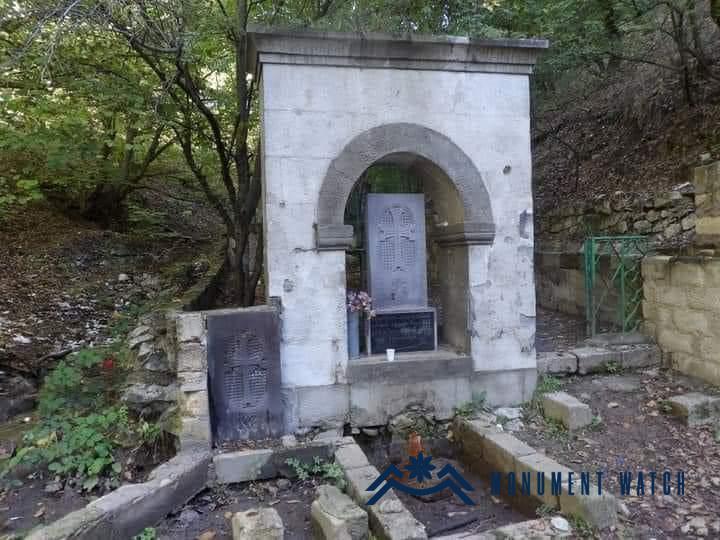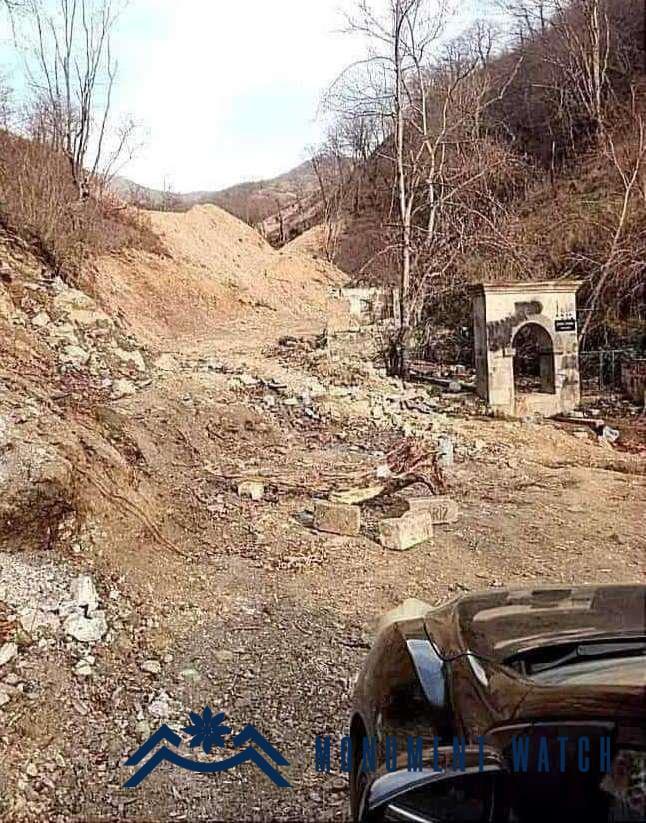Azerbaijan’s Destruction of the Spring-Monument in Aghanus Village, Kashatagh Region
The photographic evidence provided by Azerbaijan Studies expert Varsik Simonyan vividly illustrates the destruction perpetrated by Azerbaijan on the Khachkar memorial dedicated to the memory of Tigran Abrahamyan and his companions who lost their lives in the Omar mountain pass, situated in the area known as Ttu Jur in Aghanus settlement of the Kashatagh region.
Before the Azerbaijani occupation, a spring monument adorned the area, with two khachkars erected in proximity to the monument's center (Fig. 1). However, subsequent photos following the seizure of the territory reveal the distressing reality of the khachkars being destroyed and the monument's integrity being compromised, marred by defacement with paints (Fig. 2).
According to Azerbaijani news reports, there has been widespread deforestation in the vicinity of the historical spring near Aghanus village. The stated purpose is to develop a recreational area in the monument's vicinity.
Our response
Any act of destruction of Armenian cultural heritage by Azerbaijan is strictly prohibited under numerous conventions established by UNESCO, the Council of Europe, and the provisions of the International Court of Justice, among other international documents.
The disruption of the integrity of the monument spring in the occupied Aghanus settlement located in Kashatagh and the deliberate destruction of khachkars flagrantly violate established international laws.
It is crucial to underscore that the International Court of Justice has affirmed that the laws applicable in occupied territories, including provisions safeguarding cultural heritage, have attained the status of international customary law (as per Jurisprudence). Consequently, these laws serve as universal and obligatory principles binding on all states. (https://casebook.icrc.org/case-study/icjisrael-separation-wallsecurity-fence-occupied-palestinian-territory).
Customary international laws explicitly prohibit the deliberate destruction of heritage. Specifically, the 38th, 39th, 40th, and 41st rules of international humanitarian law are dedicated to the protection of cultural values(https://heritage.sensecentar.org/assets/home/sg-7-06-icrc-ihl.pdf, https://heritage.sensecentar.org/assets/home/sg-7-06-icrc-ihl.pdf, https://heritage.sensecentar.org/assets/home/sg-7-06-icrc-ihl.pdf, https://heritage.sensecentar.org/assets/home/sg-7-06-icrc-ihl.pdf).
It is important to emphasize that targeting khachkars is expressly prohibited and is deemed a grave crime against humanity. This is because since 2010 "The Art of Armenian Khachkars: The Symbolism and Craftsmanship of Khachkars" has been included in the "List of Intangible Cultural Heritage" adopted by UNESCO in 2003 (https://ich.unesco.org/en/RL/armenian-cross-stones-art-symbolism-and-craftsmanship-of-khachkars-00434) and is considered a universal value. This underscores that khachkar art possesses exceptional and comprehensive universal value, warranting additional international protection. It stands as a significant and intriguing contribution to the global cultural treasures.
The Khachkar culture is also provided with extra protection during and after wars. Specifically, the 1954 Hague Convention on the Protection of Cultural Property in Armed Conflicts, along with the principles of the second protocol adopted in 1999, provide enhanced protection for the entire Khachkar culture. Any damage caused to this culture is considered a "serious violation" under Article 15(a) of the protocol and can be prosecuted as a war crime in international courts (https://www.arlis.am/DocumentView.aspx?DocID=31415). This is corroborated by the 10th article of the aforementioned protocol on the enhanced protection of cultural values. According to this article, cultural heritage of the utmost significance for humanity should receive enhanced protection. In practice, UNESCO has officially recognized the entire Khachkar culture as falling under this category since 2010. By Article 12 of the protocol, in occupied territories, the state party to the protocol, namely Azerbaijan, bears the responsibility to guarantee the inviolability of cultural values under enhanced protection. This includes refraining from targeting such values for attack or reprisals.

